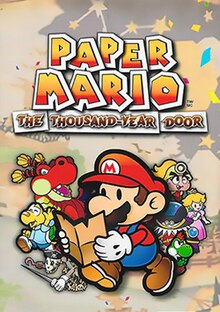
Back بايبر ماريو: ذا ثاوزند-يير دور Arabic بايبر ماريو: ذا ثاوزند-يير دور ARZ Paper Mario: The Thousand-Year Door Catalan Paper Mario: Die Legende vom Äonentor German Paper Mario: The Thousand-Year Door Spanish Paper Mario: The Thousand-Year Door Finnish Paper Mario : La Porte Millénaire French Paper Mario: Il portale millenario Italian ペーパーマリオRPG Japanese 페이퍼 마리오 1000년의 문 Korean
| Paper Mario: The Thousand-Year Door | |
|---|---|
 International packaging artwork, featuring various characters from the game, with Mario at center | |
| Developer(s) | Intelligent Systems |
| Publisher(s) | Nintendo |
| Director(s) |
|
| Producer(s) |
|
| Programmer(s) | Tadao Nakayama |
| Artist(s) |
|
| Writer(s) |
|
| Composer(s) |
|
| Series | Paper Mario |
| Platform(s) | |
| Release | |
| Genre(s) | Role-playing |
| Mode(s) | Single-player |
Paper Mario: The Thousand-Year Door[a] is a 2004 role-playing video game developed by Intelligent Systems and published by Nintendo for the GameCube. The Thousand-Year Door is the second game in the Paper Mario series following Paper Mario, and is part of the larger Mario franchise. In the game, when Mario and Princess Peach get involved in the search for a mystic treasure that holds great fortune, Peach is kidnapped by an alien group called the X-Nauts; Mario sets out to find the treasure and save the princess.
The Thousand-Year Door borrows many gameplay elements from its predecessor, such as a drawing-based art style, and a turn-based battle system emphasizing correctly timing moves. For most of the game, the player controls Mario, although Bowser and Princess Peach are playable at certain points between chapters. The game was announced at the 2003 Game Developers Conference, and was released late July 2004 in Japan and late 2004 worldwide.
The Thousand-Year Door was acclaimed at release and has since been considered one of the greatest video games of all time. It won the "Console Role-Playing Game of the Year" award at the 8th Annual Interactive Achievement Awards, and is often considered the best game in the series. A remake was released for the Nintendo Switch in 2024. The game was followed by Super Paper Mario, which was released for the Wii in 2007.
Cite error: There are <ref group=lower-alpha> tags or {{efn}} templates on this page, but the references will not show without a {{reflist|group=lower-alpha}} template or {{notelist}} template (see the help page).